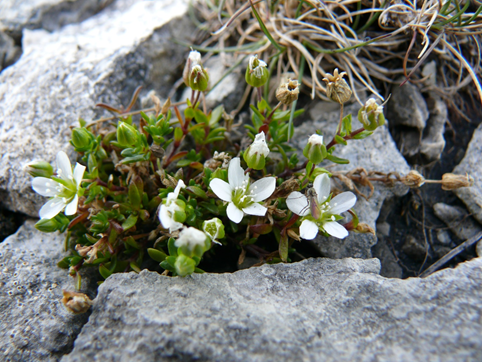#52 Yorkshire Sandwort by Kevin Walker
Meet Kevin Walker, Head of Science at the BSBI!
Dr Kevin Walker is Head of Science at the Botanical Society of Britain and Ireland, formerly at the UK Centre for Ecology and Hydrology, Monks Wood. He is a botanist with an interest in plant ecology, rare species, invasive species, montane plants, and floristic change. You can read more about his research here. He is the co-author of the Plant Atlas 2020. Alongside plants, Kevin’s interests also include birds, fungi, and bryophytes. He can be contacted at Kevin.walker@bsbi.org, or on Linkedin. He can also be found on Twitter as @BSBIscience.
Kevin’s chosen species is Yorkshire Sandwort Arenaria norvegica subsp. anglica. Yorkshire Sandwort is an annual herb whose entire world population is confined to limestone habitats on the lower slopes of Ingleborough, Ribblesdale. It was discovered by Lister Rotheray, a Skipton-based botanist, near to Ribblehead railway station in 1889 but was not recognised as distinct from subsp. norvegica until the 1950s. You can read more about Yorkshire Sandwort on the plant atlas: https://plantatlas2020.org/atlas/2cd4p9h.ycc.
Yorkshire Sandwort is one of only two plant species with its entire British and Irish distribution confined to Yorkshire (the other species being Thistle Broomrape Orobanche reticulata) – this makes it a perfect addition to this series! It is an endemic subspecies of the montane species Arenaria norvegica which occurs in eight widely scattered locations in the west and north of Scotland and at one site in the west of Ireland where it was originally discovered in 1961, but was not seen again until 2008 when it was rediscovered on Black Head in the Burren, County Clare. Elsewhere it occurs scattered throughout the mountains of Scandinavia and throughout Iceland where it is a common plant of gravelly soils and fellfield habitats.
In Britain its entire distribution is confined to the lower slopes of Ingleborough where it grows on shallow, gravelly soils on exposures of limestone including flat exposures on the edges of flushes and springs, limestone pavement, tracks, and a quarry floor. It was discovered in 1889 close to Ribbelhead Station, where it no longer occurs, but it is now known from around 30 locations centred on Sulber Pasture and on rock outcrops on or close to the Clapham Lane between Sulber and Crummack Dale. It has not been seen at outlying populations at Selside and at Dawson Close on the lower slopes of Fountains Fell since the 1990s. The only extant population away from this area is at Foredale Quarry near to Horton-in-Ribblesdale where it was discovered in the 1970s.
Kevin first became familiar with this lovely little plant back in 1993 when he was working for English Nature on Ingleborough NNR: ‘Whilst mending a wall I found an unknown population close to Sulber Nick. Intrigued by its rarity, I carried out a detailed autecological study of it as part of my MSc in Conservation at UCL the following year. I’ve been monitoring it on and off, ever since, keeping an eye on population numbers and checking up on all its 30 or so localities.’ Since the 1990s it has not fared well, possibly because of generally drier springs, but that all changed in 2019 when it had a bumper year with over 2000 plants recorded during a survey of all its populations. It does seem to be hanging on, but one wonders what the future holds for it, especially given the increased frequency and severity of droughts due to climate change.
Recording and monitoring
Yorkshire Sandwort is just one of an assemblage of montane plant species that Ingleborough NNR is famous for. Like Teesdale and Malham, it must have provided a refuge for many species during the last glaciation or an abundance of competition-free soils in the post-glacial period. Consequently, it is a mecca for botanists keen to see these elusive species, many of which have their HQ on its slopes – along with Yorkshire Sandwort these include Baneberry, Silvery Lady’s-mantle, Teesdale Violet, and Rigid Buckler Fern. The Wild Ingleborough project is aiming to raise the profile of this assemblage and restore some to their former glory. Alongside that, there are ambitious plans to survey and monitor the populations. As a result, there are lots of opportunities to get involved, either surveying or doing practical conservation to preserve this unique and threatened flora.
Further information and acknowledgements
NEYEDC would like to thank Kevin for his time and expertise in helping to create this blog.



